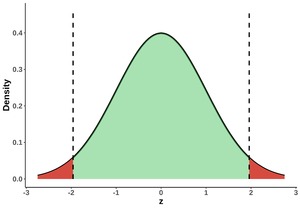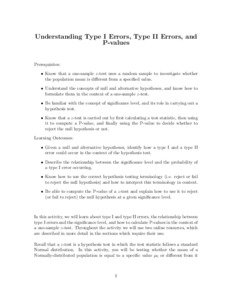
Understanding Type I Errors, Type II Errors, and P-values
(0)Learn how to calculate P-values for a one-sample z-test, how to detect Type I and Type II errors in real-life settings, and the relationship between the significance level and Type I errors.
Prerequisite Knowledge
- Know that a one-sample z-test uses a random sample to investigate whether the population mean is different from a specified value.
- Understand the concepts of null and alternative hypotheses, and know how to formulate them in the context of a one-sample z-test.
- Be familiar with the concept of significance level, and its role in carrying out a hypothesis test.
- Know that a z-test is carried out by first calculating a test statistic, then using it to compute a P-value, and finally using the P-value to decide whether to reject the null hypothesis or not.
Learning Objectives
- Given a null and alternative hypotheses, identify how a Type I and a Type II error could occur in the context of the hypothesis test.
- Describe the relationship between the significance level and the probability of a Type I error occurring.
- Know how to use the correct hypothesis testing terminology (i.e. reject or fail to reject the null hypothesis) and how to interpret this terminology in context.
- Be able to compute the P-value of a z-test and explain how to use it to make a decision about the null hypothesis (reject or fail to reject) at a given significance level.
Description
The goal of the activity is for students to develop an intuition about Type I and Type II errors, the relationship between Type I errors and the significance level, and how to calculate P-values in the context of a one-sample z-test. Students first explore how Type I and Type II errors can occur in real-life settings. They then use an interactive resource to learn how to calculate P-values of a two-sided z-test. Afterwards, they use another interactive resource to understand how the significance level is related to the probability of a Type I error. Finally, they apply what they learned in the earlier sections on an applied exercise.
Suggested Uses, Tips and Discoveries
This activity can be used as an introduction to P-values and Type I and Type II errors, specifically in the context of a one-sample, two-sided z-test. If the concepts have already been introduced in the course, this activity can also be used to solidify students’ knowledge by having them apply the concepts in real-life scenarios. However, this activity should not be used as an introduction to hypothesis testing in general, or even z-tests in particular. Students should already have some knowledge of hypothesis testing, as specified in the prerequisites section.
The activity takes about 45 minutes and is appropriate for all class sizes and formats. It can be implemented in multiple ways—as an in-class activity, in a lab, as a homework assignment, amongst others. There are four sections in the activity and they can be used in a variety of ways. The first three can be completed independently; one can be done in class and the rest left as homework assignments, for example. The fourth section is an applied exercise that uses the tools of the first three. Students can also work on the first sections during a lab or in class and complete the applied exercise on their own.
Related Resources
Web Activity: Distribution of the P-values Under the Null Hypothesis of a One-Sample Z-test
Explore the distribution of the P-values when the null hypothesis of a one-sample z-test is true.
Creator
- Di-Luvi, Gian Carlo
Resource Type
Date Approved
Access
Everyone
https://statspace.elearning.ubc.ca/handle/123456789/399

Comments
Ratings in detail